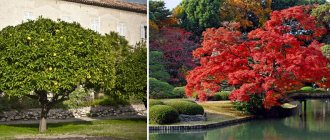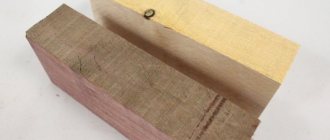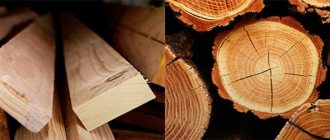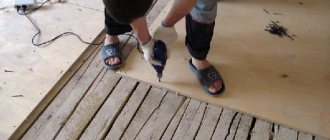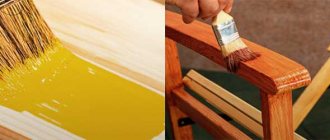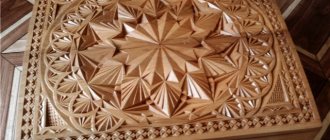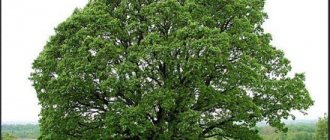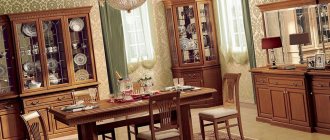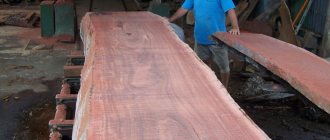If you are a beginner carver, one of the first questions you might ask is: what is the best wood for wood carving? The material is really very important in this craft. All creative ardor can cool down if the carver has chosen the wrong wood for his endeavors. In this article, you will learn what kinds of wood there are, what “hot” varieties are suitable for carved creativity, and also what the criteria for the quality of the material are made up of. And to top it off, you’ll learn how to prepare wood for carving.
Technological qualities of wood
The basic indicators for selecting wood are hardness and density. The density of the material allows it to be divided into 3 types: wood with low density, with medium density, and also species with high density data. According to hardness markers, wood can be soft, hard or super hard. Let's take a closer look at these characteristics.
Material by hardness:
- Soft breeds. These include spruce, chestnut, as well as fir, pine and willow, linden. Poplar and alder are also here. If, for example, furniture is made from this wood, it will be cheaper. Of the proposed species, the most popular will be pine. Soft woods for carving are the most comfortable to process. Soft wood bends well and sands well.
- Hard rocks. This wood characterizes deciduous varieties. This list will include beech, common birch, aspen, as well as ash and elm. Ash is a particularly valuable variety: it is a highly environmentally friendly wood with a beautiful structure and wonderful shade. Ash is somewhat reminiscent of a mighty oak, but it is still lighter.
- Superhard rocks. Hornbeam and boxwood have hardness; dogwood, white acacia and, in fact, oak can boast of it. In the furniture segment, there is no doubt that this is a valuable wood. And they make luxury furniture from it. The tree of this group is highly resistant to rot.
If you are just starting to learn carving, then try to work with soft rocks. For example, in Siberia, artisans work with cedar blanks, a material with an excellent texture that is comfortable for carving. Of the deciduous varieties, carvers like to use linden. Its wood is clean and easy to cut, but it is not suitable for large furniture products. But for the first experiments in carving, it’s fine. Wood types for carving require a whole list of materials, and they can compete with each other. And the personal preferences of the master are important.
Species and types of wood
Wood is a natural product, so no material is completely similar to each other and without defects. All types have knots, cracks, and knots. Often they do not affect the quality of the material.
The strength of wood is important for its use in building structures. But basically the choice depends on the taste of the owner of the future home. The thicker the log, the warmer the house will be. To choose the right material, you should pay attention to wood with a high quality class.
A few words about different types of wood:
What is assortment
There are GOST standards for all types of wood that describe the requirements for them. In Russia, GOST 8486-86 has been adopted, and in Europe, wood is divided into 4 grades A, B, C, D. In the construction market, wood of the second grade and class B is more in demand. Class A is mainly intended for the manufacture of furniture.
The assortment depends on the presence of defects:
- 1st grade is of high quality. Recommended for use in construction where high strength, rigidity and presentable appearance are required;
- Grade 2 is recommended for general construction purposes where appearance is not very important;
- Grade 3 is suitable for economical construction. It has good strength, but many different defects. Used for fastening rafters, for fixing, blocking - wherever strength and appearance are not important;
- Grade 4 is used for the manufacture of containers and various packaging products.
Choosing wood for wood carving
Specialists have to work with different materials for wood carving. And in addition to the objective characteristics of the varieties, there are also subjective assessments of the master. Therefore, to find your optimal option, you have to experiment.
Material characteristics:
- Pine. It has straight-grained wood with a yellowish tint, powerful and with a medium degree of drying out. It is easy to work with if the wood is not particularly resinous; it is excellent for gluing, but is not particularly convenient for finishing and painting. Almost unsuitable for small-relief carvings. But it is also used for carved decoration of buildings.
- Larch. Wood with the highest qualities. Heavy and durable, not the easiest to work with, but very durable. It will not rot from dampness. But more often it is used for building houses and making parquet.
- Tiss. Sound rock, its interior is dense and heavy, practically not rotting. A good choice for carpentry and turning needs. It is classified as a “red” breed.
- Juniper. And this is already a very interesting breed for carvers. Heavy and hard wood dries out little, it is not afraid of rotting, and retains a pleasant aroma for a long time. Excellent when cutting, good in touch-up and easy to polish. Dried juniper is considered an excellent base for carpentry. Wood is a suitable choice for fine flat-relief carvings, as well as for volumetric carvings.
- Cedar. Its structure is close to pine wood, which is why it is in demand in carving. Thus, wood looks advantageous in polished smooth products, in various kinds of crafts decorated with contour carvings.
- Oak. Dense wood with an elegant structure, medium drying and low cracking. Oak has to be processed with considerable force and with the help of high-quality, well-sharpened tools. Its wood is often used for carving and turning, and for mosaic operations.
- Bird cherry. Heavy and strong wood, it is afraid of moisture. If the tree is young, it will be white, if old, it will be reddish-brown. The material must be dried carefully. Bird cherry is distinguished by excellent cutting in all directions. This tree has always been actively used by woodcarvers.
- Apple tree. This tree has a hard, heavy material with a uniform structure. It is not easy to dry an apple tree, as it dries out a lot, but after drying it does not warp or crack. Wood behaves well in painting, sanding, polishing and glazing. Apple tree material is almost ideal for fine carving of mini-sculptures.
- Hazel. The material is simply excellent for small carving operations. Chess pieces have long been carved from hazel, as well as pencils and handles.
- Aspen. Soft, delicate wood, lends itself well to cutting with a chisel. It is used to make lightweight toys, dishes and various decor that can be decorated with carvings.
- Rowan. The reddish-brown base is not easy to process; it is strong and heavy. But for turning and carving operations, a dense and homogeneous composition is quite suitable. It was previously used for carving and chiselling crafts. Rowan root is considered an excellent preparation for sculpture.
- Alder. It is also used for carving work, and also for simulating more noble types of wood.
Separately, it is worth mentioning about birch . This is wood of medium hardness and density, its structure is uniform. It is easy to cut in different directions, drills and polishes well. But the material also has some disadvantages: birch has a high risk of cracking, warping and shrinkage. It is susceptible to wormholes and rot.
And, of course, maple - dense, bright and highly durable wood serves as the optimal basis for carving operations. Especially for applied threads.
More detailed information about wood can be obtained by watching this video:
Coniferous trees
Coniferous species have a sharper, resinous odor. In addition, the macrostructure of such wood species is better defined than that of deciduous trees. Coniferous wood species include pine, larch, fir, spruce, and cedar.
Pine
Pine is most often used as a building material. The color of pine wood can be either reddish-yellow or pale yellow, and this does not in any way affect the working properties of the wood. The wood itself is durable, light, and easy to process. In addition, due to the high resin content, the wood is very resistant to rotting and weathering. The soft structure of wood allows it to easily absorb various dyes. This also applies to varnish coatings. When dried, pine wood practically does not warp.
Spruce
Spruce is the second most important and used coniferous species. Compared to pine, spruce is in many ways inferior to it. First of all, this is caused by a large number of knots in the wood. Yes, and it lends itself to processing somewhat less easily. The wood contained slightly less resin, which affects its poor resistance to atmospheric conditions.
Cedar
Cedar, or Siberian pine, is not inferior to spruce in construction qualities, and sometimes even surpasses it. Cedar wood is very easy to work with, but just like spruce, it is not resistant to decay.
Fir
In terms of its working qualities, fir is not much different from spruce: it is easy to process and practically does not accept chemicals. Just like spruce wood, it contains little resin, which is why the wood quickly rots in the open air without special treatment.
Quality criteria
There are certain physical qualities of wood, according to which the craftsman must choose the material. The wood color, humidity, texture and smell are important to the carver. He will evaluate hygroscopicity, ability to swell and shrink. Let's consider individual criteria.
For example, the color of wood will depend on the age of the tree, on how it was exposed to external conditions, on subsequent exposure to finishing, and also on the angle of light reflection. The decorative effect of wood in crafts depends on the texture of the wood itself, on the natural pattern that is visible on the cuts.
What kind of wood should be used for wood carving:
- Since young wood is still soft and loose, and old wood is not resistant to rot and injury, wood from the middle or mature period is valuable for carvers. But different breeds have different indicators for this period. So, if you take oak, its optimal age for carving is from 80 to 150 years. For birch this age is in the range of 60-70 years, for ash it is the same. The age of a tree can be calculated by the number of so-called growth rings on a cross section.
- Wood moisture content is another significant criterion. If the products that will be made by a master are intended for use outdoors, their humidity should be 15%. And the material for such products is dried for at least 3 months outside, under a canopy. If the products will only be indoors, the wood will still have to be dried in the room.
- Freshly cut wood, of course, is not suitable for cutting. Yes, and overdried is unusable. In the first case, after drying, the material will shrink in volume and warp. In the second, even at normal humidity levels, it will absorb moisture from the air, causing it to begin to swell and crack.
Not drying and over-drying the wood will result in a problem for the craftsman. If the rock is hard and dense, then the quality of crafts made on such a basis will suffer. But soft wood for decoration does not have such problems with drying.
Be sure to look at the growth rings: the parallelism of the rings indicates the straightness of the internal structure of the tree. Wide wood layers are a sign of looseness and low strength of the wooden workpiece.
Single-growing trees are also not taken for carving; they are more susceptible to wind influence than others, because their fibers twist and their density is different.
Beginner carvers do not always know that carved products do not combine (or try not to do so) different species, as well as parts of wood. Sound hardwood shrinks less than sapwood, but the board has virtually no center of warping. When choosing wood, you should avoid defects (knots, grain bending, cracks, and also, of course, rot and wormholes).
Wood species and their applicationsThe choice of wood for artistic work is determined by a number of features. Depending on the characteristics of the material and the type of work to be done, the carver determines what kind of wood he needs.
All trees and shrubs are divided into coniferous and deciduous. Conifers have scaly or lamellar needles, their wood (except juniper, spruce and yew) is riddled with resin ducts. Almost all conifers change their needles once every three years, and only larch does this every year.
Deciduous species (except subtropical evergreens) annually shed their foliage - lamellar leaves of various shapes.
Deciduous wood does not have resin passages, but there are vessels that are part of the sap-conducting system. There are trees in which these vessels are clearly visible on the protected end. Such breeds are called large-vesseled. They are divided into ring-vascular (elm, oak, edible chestnut, ash, elm, etc.) and scattered-vascular (persimmon, walnut).
Most tree species growing in the middle zone are small-vascular. These are birch, aspen, poplar, willow, apple, rowan, alder, maple, etc.
Among deciduous trees, species with hard wood stand out: pear, maple, beech, hornbeam, walnut. Hard small-vesseled also include species growing in the southern zone: lemon, boxwood, white acacia, yew, tangerine.
To choose the right material and find out whether it will be suitable for a given type of work, you need to know what properties a particular rock has. For example, soft conifers are not suitable for relief and small flat-relief carvings. Graceful carving against the background of a colorful texture, which in itself is a decoration, will simply be “lost.”
In addition, in coniferous species the density of the early and late layers of wood differs, and it is not so easy to guide the cutter evenly. The resin content of the wood also interferes with processing. Most often, conifers are used to create monumental works.
Linden
White with a pink or faint reddish tint, linden wood is a soft, coreless species. The annual layers are not very clearly visible in all sections; the medullary rays are also poorly distinguishable. On a transverse section they look like thin shiny lines; on a radial section they appear as darkish spots. The wood is light and flexible and therefore ideal for small carvings. It lends itself well to sawing, processing with a cutter, and is easy to paint.
When dried, linden wood dries out greatly and warps.
The bast of old bark is used for the production of paper, carpentry, carved and turned products.
Soft hardwoods such as alder, aspen, and poplar have similar properties.
Alder
Alder wood is a soft species. It lends itself well to processing with cutting tools, is easy to polish, and does not create difficulties during pressing and impregnation, but drilling it is not so easy. The main characteristics are lightness, toughness, relative strength and pliability. Alder wood does not crack when dried and does not chip during carving.
When cut, the wood quickly turns yellow and often acquires a bright orange tint. Gradually the color fades and becomes grayish. After coating with drying oil or oil, it acquires a uniform, intense color that distinguishes it from other breeds. When exposed to sunlight, alder wood loses its orange tint within 2–3 months and becomes outwardly similar to pine wood.
A significant drawback of alder wood is dark brown core inclusions that disrupt its uniform texture and color. Moreover, the longitudinal lines can be both narrow and quite wide.
A detailed examination of the structure of alder shows that there is no division into sapwood and core. The outlines of the annual layers are sinuous, blurry and almost invisible. One annual layer is separated from the other by a thin dark stripe, denser than the rest of the wood. The edging is located along the entire length of the outer boundary of the layer. Numerous vessels are barely visible to the naked eye; their arrangement tends to be radial.
Alder wood is used to make musical instruments and decorative items. The alder burl is especially valuable artistically.
Aspen
Aspen wood is a non-core species. It has a homogeneous structure, thanks to which it is easily cut in all directions, peels easily, splits into even pieces, is well impregnated with various compounds, and firmly absorbs paint. Its main characteristics are lightness, elasticity and high strength, which increases over time. Young aspen, cut down in the spring during the days of sap replenishment and dried in air (without direct sunlight), acquires bone strength. Aspen wood is not afraid of moisture, does not warp or crack when dried.
When cut, the wood is light, almost white, with a slight greenish tint. Over time, it turns gray and acquires the famous silvery glow for which the roofs of northern monuments of ancient architecture are famous. Being highly resistant to weather conditions, aspen wood, even without special coatings, retains its natural appearance for decades.
The texture of this wood is fine. The annual layers are faintly distinguishable, but more noticeable than those of birch. On a radial section, you can see the medullary rays, which are narrow shiny strokes.
Due to its properties, aspen wood has a wide range of applications. It is ideal for making dishes, toys and household items. Tools with aspen handles are extremely convenient to use, as they are highly durable, lightweight and avoid the formation of calluses (unlike birch).
The ease of grinding and polishing allows the wood to be used for making solid-carved ornaments of particular complexity, decorations and handicrafts with blind carvings.
The main disadvantage is heart rot, which is often found in aspen stem wood. This complicates woodworking (turning, drilling, etc.) and makes the yield of parts low.
Poplar
Poplar softwood has whitish or light brown sapwood and a heartwood that varies in color from yellow to dark brown. The wide growth rings are clearly defined, but the vessels are almost indistinguishable. Most often they evenly cover the growth rings, but sometimes they appear as radial rows.
The surface of the radial cut is slightly shiny, the vessels on it have the appearance of small grooves. The medullary rays are thin and almost invisible in any section.
Poplar can be processed well with cutting tools, although not as freely as linden, because the cutter gets a little stuck in the wood.
Widely used as an ornamental material.
Ash
Ash wood is a sound wood species. Characterized by high strength, elasticity and durability. It can be easily processed with cutting tools and can be easily polished, but requires filling during finishing. Wood carvers highly value it for its beautiful designs.
When cut, the wood core is light brown in color, gradually turning yellowish-white in the sapwood area.
The texture of the wood is ring-pore, with clearly visible wavy lines running along the rings. The vessels are thick-walled, interspersed with numerous narrow medullary rays. Ash wood is used to make furniture, parquet and stair railings. The main disadvantage of ash is the length of the drying process and the frequent formation of cracks. Cracking of finished crafts can be avoided if all drying rules are followed.
Quince
Quince wood is one of the non-nucleated species. It can be easily processed with a cutting tool, can be easily polished, and is suitable for any type. The wood texture is light. Quince wood is moderately durable and does not crack during drying. The main disadvantage is poor rot resistance.
There is no visible division into heartwood and sapwood; growth rings are not visible to the naked eye. Fibrous vessels are scattered throughout the wood. The vessels are of the same type, differing in the length of the segments.
When cut, the wood is colored light yellow, often with a pinkish tint.
Its beautiful design makes it one of the favorite materials for small carved or craft craftsmen.
Birch
Birch belongs to the sapwood species. Its wood is painted white with a yellowish or slight reddish tint. The coloring is uniform throughout the entire section of the trunk. Tree rings are faintly visible in all sections. On the outside of the growth rings you can see a thin strip - the later part of the annual layer of wood. It is darker than the earlier part. The annual layers are not wide; in a cross section, their boundaries are clearly visible.
In a transverse section, evenly scattered small vessels are visible; in a longitudinal section, the vessels are almost invisible, but if you look at them through a magnifying glass, they appear as small strokes. Narrow core rays are practically invisible on tangential and end sections, but on radial sections they are visible as short strokes and dots. Thanks to the medullary rays, the longitudinal surfaces of the birch appear shiny. The medullary rays crossed by the vessels bend, and when crossing the growth rings they expand.
Birch wood lends itself well to mechanical processing and cuts well. It is not difficult to turn it on a lathe.
Cherry
Wood with heartwood and sapwood. The sapwood is yellow, light yellow or whitish, the heartwood is brownish or dark brown, and may have a greenish or brown tint. Tree rings are clearly visible. The wood is scatteredly vascular, sometimes with slightly pronounced annular vascularity. It is hard, but can be processed well, so it is often used for finishing work and making decorative crafts.
Oak
Oak wood is very strong, resistant and heavy, and dries well. Has many medullary rays. The kernel is brown with a grayish-green tint. In the widest part of the spring wood, large vessels can be seen scattered in places.
Wood can be easily processed with cutting tools, can be painted and varnished well.
Hawthorn
Reddish or pink wood with a dark core and clearly visible growth layers. It is easy to process with almost any cutting tools, and lends itself well to painting and varnishing.
Suitable for carved and turned products. Due to its strength, it is often used to create handles for percussion instruments.
Chestnut
Wood with heartwood and sapwood, annual layers are clearly visible on all cuts. The sapwood is yellow-white, the heartwood is yellowish-brown. The chestnut bark is smooth. The medullary rays are thin and not noticeable in a cross section.
Chestnut wood is slightly softer and lighter than oak. It can be easily processed with cutting tools, is perfectly polished and retains its external finish for a long time.
Beech
Yellowish (sometimes with a reddish tint), without shine, beech wood has a false core, colored reddish-brown. Annual layers and broad rays are clearly visible in all sections. Narrow rays can only be seen on the end section.
The wood has a colorful grain and has physical and mechanical properties similar to those of oak, birch and ash.
Dries well, dries quickly, but may warp slightly. If not dried properly it will crack. Hard and quite heavy, well processed and easy to prick. Among the advantages are flexibility and plasticity, one of the disadvantages is instability in relation to putrefactive processes.
Carvers should remember that beech core does not soak well, but can be easily sawed and finished.
Hornbeam
Sapwood with no visible core. Wood without shine, uniform grayish-white color. The annual layers are clearly visible due to the sinuous contours. The vessels cannot be seen without a magnifying glass. On a radial section, dim medullary rays can be seen.
Hornbeam wood is hard and durable. It is difficult to process, but it paints well. Imitations of ebony are sometimes made from it.
Nut
Wood with a colorful texture, gray-brown or brownish-brown heartwood, with irregular darkish veining. There are specimens of different colors - from very light to yellowish-gray. When artificially dried, the wood acquires a dark gray tint. The sapwood is grayish-brown, wide. In all sections, the vessels and annual layers are clearly visible.
The wood is heavy and hard and can be easily processed with all cutting tools. Easy to paint, varnish and polish.
Sycamore
It has a reddish-brown core and sapwood colored grayish. False medullary rays give the wood a silvery sheen. The annual layers and small vessels are almost invisible, but the medullary rays are wide and visible in all sections. On a radial cut, the rays form a pattern characteristic only of sycamore.
The wood is heavy and does not rot. Dries well, but slightly warps.
It is easy to process, can be sawed, but is very poorly saturated with dyes.
Plane tree wood is used for carpentry and turning, as well as for artistic and decorative works.
Juniper
A heartwood species with a grayish or reddish-brown core and pink-white narrow sapwood.
The wood has a low shine, beautiful texture, and a very pleasant smell. It has good mechanical properties, strength and durability. Perfectly amenable to any type of mechanical processing. Used for turning products. Since ancient times, toys, canes, and chess pieces have been carved from it.
Thuja
A soundwood with orange-brown or dark-brown heartwood and whitish-yellow sapwood. Dries well. The wood is not very strong and moderately resistant. Easily processed with cutting tools, excellent polishing. Used for turning and threaded products.
Sea buckthorn
The core ring-vascular species has a brownish-yellow core and light yellow sapwood. On all sections, growth rings and striae are clearly visible; the narrow medullary rays are almost invisible.
Dries well and is not susceptible to warping or cracking. It has high strength, hardness, and resistance to rotting. It is well processed with cutters and knives, perfectly varnished and polished. Sea buckthorn wood is used mainly for carpentry, turning and carving work.
Holly holly
White wood with a greenish or grayish tint. Without a visible core, it has a fine and fairly even texture. The fibers are arranged in a disorderly manner, making holly wood difficult to process. This can only be done using tools with very sharp cutting edges, using a cutting angle of no more than 20°.
It paints and polishes well, and glues well. It is often used as an imitation of boxwood, and when tinted - ebony. Used for the production of turning products, decorative crafts, inlays, mosaics, engraving boards.
Eucalyptus
This tree is native to Australia and Oceania. Eucalyptus also grows in the Philippines, Indonesia, and on the Black Sea coast of the Caucasus.
The plant includes about 500 species in its genus, the most common and famous of which are giant eucalyptus and globulus eucalyptus.
On the territory of Russia, the most frost-resistant Dalrymple eucalyptus is most often found - a species with light sapwood and a brown core, which has high strength and biostability.
Eucalyptus wood is suitable for cutting, planing, and its surface can be easily sanded.
Yarra
The name "yarra" is the trade name of a species of Australian eucalyptus. The wood of this species is distinguished by its bright color - from strawberry to dark red. Over time, wood can take on a wide variety of shades. Yarrah is hard, durable and resistant to pests and fire; it polishes and sands well, but is quite difficult to machine and also warps when twisting in the direction of the grain.
Yarra wood can be used to make flooring, furniture and decorative items.
Rosewood
The name “rosewood” combines different species that have wood similar in structure and color. The most commonly used name for rosewood is the wood of Dalbergia nigra, which grows in Brazil, or rosewood, which is native to Southeast Asia.
Rosewood is a hearty, diffusely vascular hardwood. A distinctive feature of this wood is the presence of large vessels. In rosewood there are serious differences between the sapwood and mature wood: the sapwood is usually grayish-white, sometimes with a pinkish tint, and narrow; ripe wood is dark brown with light longitudinal veins, sometimes with a lilac or purple tint.
Rosewood wood is durable and hard, and is easy to cut, sand and polish. Drying wood of this species is quite often problematic - due to the acceleration of the process, numerous cracks may appear.
Table of contents
Foreign breeds
Sequoia grows primarily in North America. This is the largest tree on the globe and is distinguished by its great durability. Trees with a height of 120 meters and a diameter at the butt of 15 meters at the age of 6000 years have been preserved. It is bred and well cultivated on the southern coast of Crimea and the Black Sea coast of the Caucasus.
In terms of physical and mechanical properties, sequoia is close to spruce wood, but is more resistant to decay. Sequoia wood is used in furniture production, for finishing cars, cabins, and in pencil production.
Red tree . Under the name mahogany in international trade there is wood from a number of tree species that produce red wood of various shades.
The most common species in terms of beauty and color of wood is American mahogany, which grows in Central America.
Mahogany wood has high mechanical properties, almost does not warp or crack, and is well polished. It is used for the manufacture of high-quality furniture, interior decoration of passenger cars, and steamship cabins.
Ebony. Species that produce black wood are traded under this name. One of the best varieties is Indian black, or ebony, wood, which grows in India.
This wood is used for the manufacture of woodwind instruments, piano keys, and for inlays in furniture production.
Buckout is an evergreen tree native to tropical areas.
Backout wood is very dense, hard, heavy, with a vanilla scent. It is difficult to process and difficult to split. Backout wood contains up to 26% resin and about 3% mucous substances. Which with water give an emulsion and thereby reduce friction.
Backout wood is used for the manufacture of machine parts that require hardness and high abrasion resistance.
Rosewood. The wood is very heavy, dries out little, and polishes well. It is used to make pianos, artistic furniture, and type-setting parquet.
Each type of wood has mechanical properties and is characterized by the wood’s ability to resist external forces, as well as technological properties.
The mechanical properties of wood include: strength, hardness, impact strength (Table 1)
| Tree species | Density kg/m3 (at 12% humidity) | Tensile strength, MPa | End hardness, MPa | Impact strength, J/m2 (at 12% humidity) | |||
| Compression along the fibers | Static bend | Shearing along the grain | |||||
| Radial | Tortsovoye | ||||||
| Conifers | |||||||
| Larch | 660 | 65 | 112 | 9,9 | 9,4 | 44 | 51 993 |
| Scots pine | 500 | 49 | 86 | 7,5 | 7,3 | 29 | 41 202 |
| Spruce | 445 | 45 | 80 | 6,9 | 6,8 | 26 | 39 240 |
| Siberian fir | 375 | 39 | 69 | 6,4 | 6,5 | 28 | 29 430 |
| Deciduous | |||||||
| Hornbeam | 800 | 60 | 137 | 15,6 | 19,4 | 91 | 99 081 |
| Ash | 680 | 59 | 127 | 13,9 | 13,4 | 80 | 88 290 |
| Beech | 670 | 56 | 109 | 11,6 | 14,5 | 61 | 80 442 |
| Oak | 690 | 58 | 108 | 10,2 | 12,2 | 68 | 76 518 |
| Birch | 650 | 55 | 110 | 9,3 | 11,2 | 47 | 93 195 |
Table 1. Indicators of physical and mechanical properties of wood
Hardwoods
Trees that have properties an order of magnitude higher than conifers include birch, ash, maple, oak, etc. They are used to a lesser extent in construction.
The bending strength of birch is greater than that of pine: it is 99 MPa. At the same time, birch wood has less weight and is more resistant to damage. Handles for various tools are often made from birch bars. It is also used to create frames for upholstered furniture. Birch lumber has a light, almost white color.
A distinctive feature of oak wood is its high density. It is 800 kg/m3. Also, oak species are harder than others. Such features allow the use of oak in industry. In addition, oak wood is used to create exclusive furniture, various musical instruments and decorative interior elements.
Oak lumber can range from light to dark brown in color. Such wood is much more expensive than pine, which is due to its properties and the fact that oak grows much longer. As a result, it takes longer to renew the forest resource.
Coniferous wood
In modern residential and industrial construction, there is usually a need for frames - they can be temporary or permanent. Floors in houses are also made, rafters, scaffolding and scaffolding are created. For such structures, softwood lumber is most often used. Preference is given to him because:
- Coniferous trees are widespread not only in Russia, but throughout the planet.;
- they are characterized by rapid growth. Accordingly, the rate of timber harvesting is high;
- Coniferous lumber is affordable.
In addition, spruce is less susceptible to rotting and insect attacks. Coniferous trees have a bending strength of 74 to 79 MPa.
Despite the similarity of characteristics, spruce differs from pine. If we talk about a board made from these trees, the difference is as follows:
1. Spruce has a light, almost white color. Small knots on its surface are located quite often - approximately every 200-300 mm. Also, such lumber has low resin content, and the texture of the wood fibers is fine. In addition, the fibers contain so-called pockets in which resin accumulates. It flows out when the lumber is heated. The bark beetle also likes to eat such trees. This is evidenced by small holes in the wood structure.
2. Pine is yellow-brown in color and has large grains. Knots on the surface of the lumber are located every 600-1000 mm. In addition, pine has slightly more weight than spruce. This is due to the fact that it is more saturated with resin.
Larch occupies a separate group among the wood of coniferous trees. It has a bending strength that reaches 97 MPa. Larch also has an unusual property: the wood becomes stone if it is in water. Outwardly, it resembles spruce, but is about 2 times heavier.
Softwood
According to the structure of wood, hardwood species are divided into ring-vascular and scatter-vascular. All species with a ring-vascular structure usually have hard wood, but species with a disseminated vascular structure have both soft and hard wood. Alder, linden, aspen and birch are soft woods.
Alder
There are two known types of this tree - black alder and gray (in our country black is more common). It got its name because of the color of the bark. Alder loves moist soil. Immediately after cutting, the wood has a white color, which turns red when exposed to air. Dried alder wood has a very beautiful and unusual pink color. It is not subject to shrinkage, does not crack, is very soft, and does not deteriorate from moisture.
Types of wood:
Pine
There are many varieties of pine, widely used in construction and for the manufacture of certain types of furniture.
Red tree
The species, native to Honduras and Africa, is widely used in furniture production, usually in the form of veneers.
Elm
A good general purpose material used in shipbuilding, as a structural material and for turning.
Cedar
Lightweight and durable, cedar wood turns gray over time. Used for making stairs and window frames.
Douglas fir, or otherwise Liarsuga
Very tall trees, the wood of which is used as a structural material in furniture and plywood production.
Beech
The wonderful fine-grained beech wood is suitable for furniture, woodturning and toy making, but not for outdoor products.
Oak
Very strong and durable oak wood is necessary for construction work and in the manufacture of furniture.
Chinara
Light wood. Used in the manufacture of furniture and small parts, such as turning products.
Teak
Heavy and durable teak wood is used in carpentry, furniture production and shipbuilding.
Birch
Moderately hard birch wood is widely used in carpentry and furniture production.
Bog oak
Stained European oak, which has a brown color, is highly valued as a facing material for furniture.
Ebony
It has extremely hard and expensive wood. Used in the manufacture of keys for musical instruments, chess pieces, etc.
Larch
Moderately soft larch wood is used both in furniture production and for the manufacture of piles, posts, sleepers, and floors.
Black walnut
An excellent material for making furniture and turning products.
Ash
Very hard and durable ash wood is used to make tool handles and sports equipment. Excellent material for turning work.
Afromosia
Grows in West Africa. Used in the manufacture of furniture. Sometimes it stains under mahogany.
Silver maple
Part of the maple wood with marks from underdeveloped branches is used in the form of veneer.
American linden
Lightweight hardwood. Used to make cases, toys, and some types of furniture.
Entandrophragm
Grows in Africa. It is used to make decorative furniture, usually in the form of veneer.
